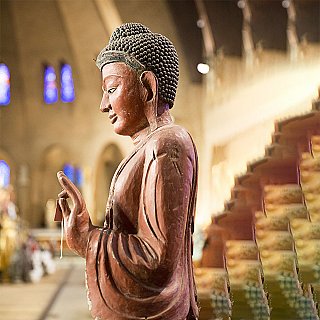Four Gates Pagoda

View our collection of Burmese Nats in our gallery
The Four Gates Pagoda is a stone Chinese pagoda erected in a Sui dynasty. It is believed that the pagoda is the oldest remaining pavilion-style stone pagoda in China. The pagoda is located at the foot of Qinglong Mountain, near Liubu Village, in Licheng District. As inscribed on a stone tablet discovered inside the pagodas ceiling in 1972, the pagoda was built in the seventh year of the Daye period of the Sui dynasty. This is the year 611 AD near the end of the dynasty.
The pagoda is constructed to the east of the site of the Shentong Temple. Literally, the Shentong Temple means Supernatural Power Temple and this was one of the most important temples in northern China when it was built. The temple, now, is in ruins state.
Architecture of the Four Gates Pagoda

During the Sui dynasty, stone and brick were introduced as a material for building pagodas. Therefore, the Four Gate Pagoda is also built using stone and brick. The blocks used for the pagoda are the hard local rock. The design of the Four Gates Pagoda is one-storey, pavilion-style pagodas. The pagoda has a square cross-section delineated by plane side walls. It is found that all elements of the structure are symmetrical with four identical sides. These sides face four cardinal directions respectively. In the centre of each wall, there is a door with straight sides and round arch on top. The roof of the pagoda is pyramid shaped and consists of 23 tiers of overlapping stone slabs. These slabs are supported by 5 tiers of stone eaves. The stone steeple is placed at the tip of the roof. The overall shape of the steeple resembles a box-shaped pagoda and is carved with Buddhist scriptures. The steeple sits on its own the Sumeru pedestal with more stone corner decorations in the shape of banana leaves. The spire of the steeple is made up of 5 stone discs. The total height of the pagoda is 10.4 m while each side measures 7.4 m long.
Interior of the pagoda

The interior of the pagoda consists of the large central pillar with the square cross-sections. The space or corridor between the surface of the central pillar and the inner side of the walls leads to the entire pillar system of the pagoda. The roof of the pagoda is supported by 16 triangular beams which link the outer walls to the central pillar. On each side of the central pillar, seated Buddha statues are placed. These Buddha statues are associated with five Dhyani Buddhas. Only the fifth one is not placed in the pillar. These Buddhas are Subtle-voiced Buddha on the northern wall, Ratnasambhava Buddha on the southern wall, Akshobhya Buddha on the eastern wall, and Amitabha Buddha on the western wall. On the bases of the statues, there is an inscription dated to the year 544 AD. It was during the period of the Eastern Wei Dynasty. As mentioned in the inscription, these Buddha statues were commissioned by Yang Xianzhou, high-ranking military official to commemorate his ancestors on the occasion of the anniversary of his father's death. Hence this document supports the statues being older than the pagoda.
Among the four Buddha statues, one of the Buddha head of Akshobhya Buddha was sawed off and was stolen in 1997. It was later returned in 2002.
Surroundings of the pagoda
There is an ancient pine tree next to the four gates pagoda. It is believed that the pine tree which stands there for more than thousand years old. Therefore, this tree is also known as "Thousand Year Pine" or "Nine-tip Pine". There are two other pagodas, named Dragon and Tiger Pagoda, and Minor Dragon and Tiger Pagoda, which were constructed during the Tang dynasty.
Share this page













































-small.jpg)



